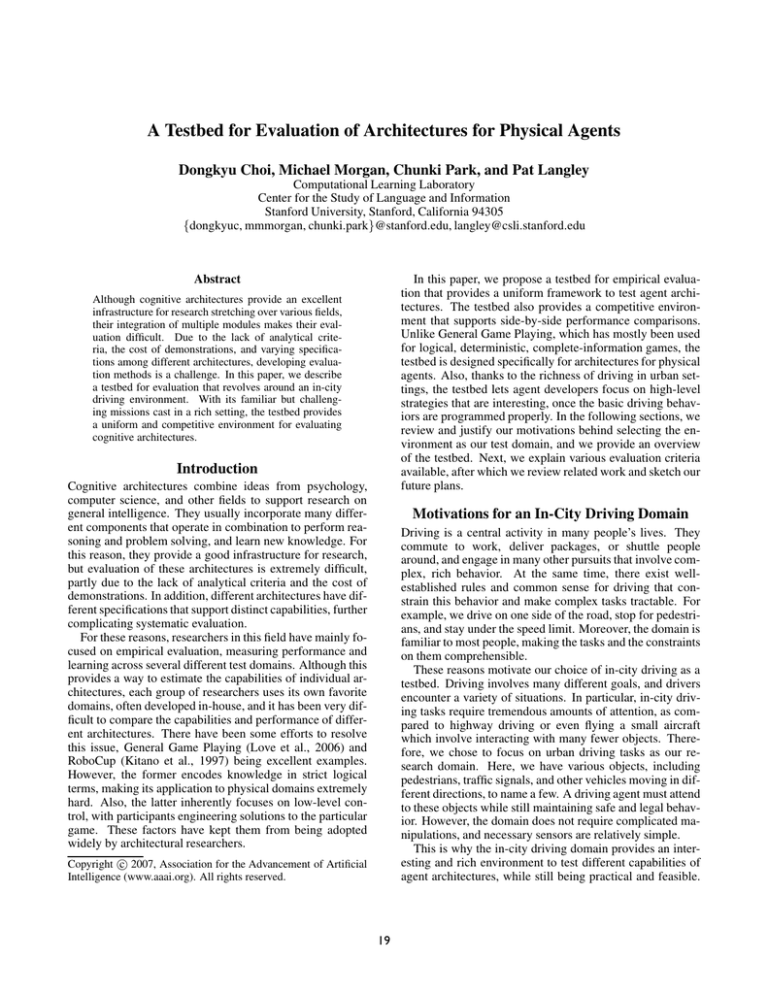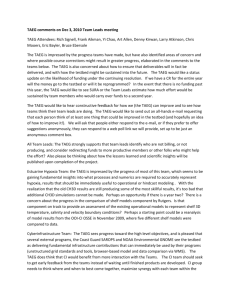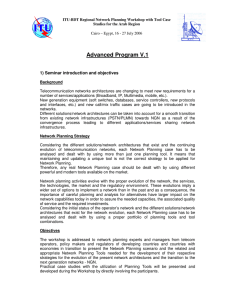
A Testbed for Evaluation of Architectures for Physical Agents
Dongkyu Choi, Michael Morgan, Chunki Park, and Pat Langley
Computational Learning Laboratory
Center for the Study of Language and Information
Stanford University, Stanford, California 94305
{dongkyuc, mmmorgan, chunki.park}@stanford.edu, langley@csli.stanford.edu
Abstract
In this paper, we propose a testbed for empirical evaluation that provides a uniform framework to test agent architectures. The testbed also provides a competitive environment that supports side-by-side performance comparisons.
Unlike General Game Playing, which has mostly been used
for logical, deterministic, complete-information games, the
testbed is designed specifically for architectures for physical
agents. Also, thanks to the richness of driving in urban settings, the testbed lets agent developers focus on high-level
strategies that are interesting, once the basic driving behaviors are programmed properly. In the following sections, we
review and justify our motivations behind selecting the environment as our test domain, and we provide an overview
of the testbed. Next, we explain various evaluation criteria
available, after which we review related work and sketch our
future plans.
Although cognitive architectures provide an excellent
infrastructure for research stretching over various fields,
their integration of multiple modules makes their evaluation difficult. Due to the lack of analytical criteria, the cost of demonstrations, and varying specifications among different architectures, developing evaluation methods is a challenge. In this paper, we describe
a testbed for evaluation that revolves around an in-city
driving environment. With its familiar but challenging missions cast in a rich setting, the testbed provides
a uniform and competitive environment for evaluating
cognitive architectures.
Introduction
Cognitive architectures combine ideas from psychology,
computer science, and other fields to support research on
general intelligence. They usually incorporate many different components that operate in combination to perform reasoning and problem solving, and learn new knowledge. For
this reason, they provide a good infrastructure for research,
but evaluation of these architectures is extremely difficult,
partly due to the lack of analytical criteria and the cost of
demonstrations. In addition, different architectures have different specifications that support distinct capabilities, further
complicating systematic evaluation.
For these reasons, researchers in this field have mainly focused on empirical evaluation, measuring performance and
learning across several different test domains. Although this
provides a way to estimate the capabilities of individual architectures, each group of researchers uses its own favorite
domains, often developed in-house, and it has been very difficult to compare the capabilities and performance of different architectures. There have been some efforts to resolve
this issue, General Game Playing (Love et al., 2006) and
RoboCup (Kitano et al., 1997) being excellent examples.
However, the former encodes knowledge in strict logical
terms, making its application to physical domains extremely
hard. Also, the latter inherently focuses on low-level control, with participants engineering solutions to the particular
game. These factors have kept them from being adopted
widely by architectural researchers.
Motivations for an In-City Driving Domain
Driving is a central activity in many people’s lives. They
commute to work, deliver packages, or shuttle people
around, and engage in many other pursuits that involve complex, rich behavior. At the same time, there exist wellestablished rules and common sense for driving that constrain this behavior and make complex tasks tractable. For
example, we drive on one side of the road, stop for pedestrians, and stay under the speed limit. Moreover, the domain is
familiar to most people, making the tasks and the constraints
on them comprehensible.
These reasons motivate our choice of in-city driving as a
testbed. Driving involves many different goals, and drivers
encounter a variety of situations. In particular, in-city driving tasks require tremendous amounts of attention, as compared to highway driving or even flying a small aircraft
which involve interacting with many fewer objects. Therefore, we chose to focus on urban driving tasks as our research domain. Here, we have various objects, including
pedestrians, traffic signals, and other vehicles moving in different directions, to name a few. A driving agent must attend
to these objects while still maintaining safe and legal behavior. However, the domain does not require complicated manipulations, and necessary sensors are relatively simple.
This is why the in-city driving domain provides an interesting and rich environment to test different capabilities of
agent architectures, while still being practical and feasible.
c 2007, Association for the Advancement of Artificial
Copyright Intelligence (www.aaai.org). All rights reserved.
19
Table 1: An example of object information that an agent
perceives in the environment.
((SELF ME SPEED 0.0 WHEELANGLE 0 THROTTLE 0
LIMIT 25 BRAKE 0 SEGMENT S1734 HITS 0)
(STREET FIRST) (STREET SECOND) (STREET B)
(INTERSECTION S1812 STREET B CROSS FIRST
DIST 5.73842)
(SEGMENT S1734 STREET B DIST 88.986)
(SEGMENT S1767 STREET FIRST DIST 19.7416)
(BUILDING B1659 ADDRESS 8 STREET FIRST
C1ANGLE 82.8411 C1DIST 33.6707
C2ANGLE 58.9024 C2DIST 40.6854)
(BUILDING B1682 ADDRESS 1 STREET B
C1ANGLE 45.4169 C1DIST 35.197
C2ANGLE 32.5563 C2DIST 49.2716)
(LANE-LINE WHITE1 COLOR WHITE
DIST 11.65 ANGLE -84.8146 SEGMENT S1767)
(LANE-LINE YELLOW2 COLOR YELLOW
DIST 5.814 ANGLE 4.83383 SEGMENT S1734)
(PACKAGE P1 ADDR 5 STREET A DELIVERED N)
(PACKAGE P2 ADDR 1 STREET B DELIVERED N))
Figure 1: A screen shot of the in-city driving domain.
Also, it is a very familiar environment to agent developers,
as they encounter similar situations every day.
A Testbed for Evaluation of Architectures
Previously, we developed a two-dimensional version of an
in-city driving domain (Choi et al., 2004) and used it as a
testbed for our I CARUS agent architecture (Langley & Choi,
2006). Although the visualization was not up to the standards of modern video games, it provided a rich environment
with various objects an agent can interact with, including
streets with lane lines, sidewalks, buildings with addresses,
traffic signals and drone cars. We gave the agent the task of
driving a car in the city, pursuing goals like package delivery.
Although the domain provided an excellent testbed for our
initial research purposes, we soon discovered its shortcomings, especially in its description of vehicle dynamics and
the visualization of the environment. In this context, we
started to design and implement a new in-city driving environment.
Table 2: Sample actions that an agent can execute in the
environment.
(*cruise)
(*gas %pedal)
:
:
(*brake %pedal)
:
(*straighten)
:
(*steer angle)
:
NO OP
push the gas pedal
at the given
percentage
push the brake pedal
at the given
percentage
straighten the
steering wheel
steer at the
given angle
Implementation
To build this new testbed, shown in Figure 1, we used the
Torque Game Engine (TGE), a three-dimensional game engine developed by GarageGames. It provides convenient
and well-built templates for three-dimensional games, as
well as robust networking capabilities, a C++-like scripting
language, a terrain generating tool, and other powerful tools
for game developers. Also, the game engine lets us develop
new games in cross-platform computing environments including Linux, Mac OS X, and Windows.
The game engine provides a ready-made physics module for vehicles that not only has realistic default parameters but also allows user-defined settings. We used TorqueScript, a scripting language the game engine provides, for
the interface between the new domain and our Lisp-based
architecture, as well as several customized mission maps.
The language supports a sufficient complement of functions,
including mathematical, standard input/output, basic object
manipulation, and other helper functions. Scripts written in
this language do not need to be compiled with the main game
engine, providing flexibility for many different applications.
Since our simulation is based on TGE, architectures can
directly connect to the testbed in C++ language. However,
the testbed also provides an interface for Lisp-based architectures. Through the interface, agent architectures can receive information on perceived objects in the environment
and execute actions in the world. Table 1 shows examples of
perceptions an agent can obtain from the world, and Table 2
gives some sample actions available in the environment.
Tasks Supported
Like people, an agent in the domain can work on many different tasks. We can have it simply drive around without
hitting pedestrians as they cross streets, or it can pursue additional tasks, including:
20
• delivering packages to multiple addresses,
Support for Agent Capabilities
• picking up passengers and dropping them off at various destinations,
Our urban driving testbed also supports a variety of functional capabilities that are relevant to research on cognitive
architectures, but that are seldom studied for lack of an appropriate environment. These include:
• chasing another car and issuing tickets like police,
• driving an ambulance with patients to hospitals, or
• pursuing multiple goals, such as reaching a destination
rapidly, driving safely, and obeying traffic laws;
• joy-riding in a sports car as fast as possible.
• managing limited resources, ranging from physical
quantities like gasoline to the agent’s perceptual attention;
Each of these tasks specifies a particular goal for the agent;
they also involve different parameters for the mass, height,
engine torque, and braking capability of the vehicle an agent
will drive. The testbed provides an interface that supports
easy changes of goal and parameters. The tasks are intended
to test capabilities of agents ranging from sensory-motor
control to high-level decision making and planning.
• encoding, using, and learning spatial knowledge in
terms of places and routes that connect them;
• storing and retrieving episodic memories about events
the agent has encountered and activities it has pursued;
• representing and exhibiting emotions like frustration
and anger, along with the physical responses they
elicit.
Evaluation Criteria
One should consider various dependent measures at different levels when evaluating integrated systems (Langley &
Messina, 2004). The testbed provides basic and combined
measures suitable for driving situations, and could allow
comparisons with other architectures as well as baseline systems of the user’s choice.
Whenever an agent drives a vehicle in the simulated city,
the testbed stores key variables like the location, velocity,
and heading at predefined intervals. In addition, it records
the number of undesirable behaviors, such as:
These capacities in turn suggest additional ways to evaluate agent architectures that move beyond the simple metrics
outlined above, but we will reserve discussion of them for
another paper.
Related Research
• average speed and the number of tickets received.
There have been some efforts to provide testbeds for empirical evaluation of architectures. The World Modelers
Project (Langley et al., 1981), one of the first such attempts,
provided a simulated physical environment that aimed to
support research on integrated intelligent systems at a time
when robotic platforms were still unreliable.
More recently, RoboCup (Kitano et al., 1997) has provided a popular testbed for artificial intelligence and robotics
research, and it has promoted research and competitions for
a decade. However, as the competition has grown larger, the
recent focus has been more on winning techniques specific
to the game, rather than on the fundamental research issues
that were originally pursued.
TacAir-Soar (Jones et al., 1999) showed extensive capabilities of a cognitive architecture, and confirmed the possibility of using physical simulations to evaluate such systems.
But the testbed was designed for military training exercises
and has not become widely used in the AI community.
General Game Playing (Love et al., 2006) is a more recent testbed that has hosted competitions since 2005. With
its logical description language, the testbed provides complete specifications of games to players, letting them focus
on decision-making processes. It supports a broad class of
games, but it is inappropriate for complex physical settings
that involve continuous space, many interacting entities, and
partially observable environments.
These criteria are designed to measure the agent’s success
during the missions in both continuous and discrete scales,
providing additional evaluation measures for architectures.
Our work is still in its early stages, and we plan to improve
the in-city driving domain and develop it into a uniform
• hitting pedestrians,
• collisions with other vehicles and buildings,
• driving faster than the posted speed limit,
• driving on the wrong side of road, and
• violations of traffic signals.
During post-processing, the basic driving behavior can be
evaluated using these traces, providing measures of the
agent’s driving quality. The testbed supports one or more
mission-specific evaluation criteria, such as:
• delivery time and the number of delivery errors,
• the time between pick up and drop off, along with the
number of errors,
• the time needed to overtake other vehicles and the
number of tickets issued,
• the time between pick up and drop off of patients at
the emergency room, and
Directions for Future Work
21
Kitano, H. Kuniyoshi, Y. Noda, I. Asada, M. Matsubara,
H. & Osawa, E. (1997). Robocup: A challenge problem
for AI. AI Magazine, 18, 73–85.
Langley, P., Nicholas, D., Klahr, D., & Hood, G. (1981). A
simulated world for modeling learning and development.
Proceedings of the Third Conference of the Cognitive Science Society (pp. 274–276). Berkeley, CA.
Langley, P., & Messina, E. (2004). Experimental studies of integrated cognitive systems. Proceedings of the
Performance Metrics for Intelligent Systems Workshop.
Gaithersburg, MD.
Langley, P., & Choi, D. (2006). A unified cognitive architecture for physical agents. Proceedings of the Twenty-First
National Conference on Artificial Intelligence. Boston:
AAAI Press.
Love, N. C., Hinrichs, T. L., & Genesereth, M. R. (2006).
General game playing: Game description language specification (Technical Report LG-2006-01). Logic group,
Department of Computer Science, Stanford University,
Stanford, CA.
testbed that developers can use to evaluate their cognitive
architectures in a competitive environment. We intend to
implement many additional features, the most important being support for multiple agents. The current testbed supports
only single agent missions, which restricts the scope of evaluation. With multiple agents simultaneously running in the
world, possibly controlled by different architectures, we can
introduce more competitive missions. Racing to flags, playing hide and seek with other agents, and chasing each other
are some examples.
The great advantage of in-city driving is that it supports
many alternative tasks in a single physical environment.
This should let researchers evaluate the generality of their
architectures with relatively little effort. However, to support such evaluations, we must specify more formally the
set of driving tasks outlined earlier and the metrics associated with them. This will be another priority for our future
work.
Conclusions
Cognitive architectures provide an important path toward
developing intelligent systems, but their integrated nature
make their evaluation impractical with analytical methods.
In response, we have proposed an in-city driving testbed that
supports empirical evaluation of such architectures.
This domain is a familiar but challenging environment
for physical agents. Although it is rich with many objects
and many possible tasks, it is reasonably constrained, with a
small set of manipulators and relatively simple sensors. Incity driving supports a variety of achievement and maintenance goals that interact to produce complex behavior. With
multiple missions and corresponding evaluation criteria, it
provides a promising testbed for empirical evaluation of architectures. We hope to package the environment and make
it available online in the near future.
Acknowledgements
This material is based on research sponsored by DARPA
under agreement numbers HR0011-04-1-0008 and FA875005-2-0283. The U. S. Government is authorized to reproduce and distribute reprints for Governmental purposes
notwithstanding any copyright notation thereon. Discussions with Negin Nejati and Tolga Konik contributed to the
ideas we have presented in this paper. Authors would also
like to thank GarageGames for allowing the free use of its
products, including Torque Game Engine 1.4.2, BTCP Car
Pack, and Urban Pack 1.0.0 for our development.
References
Choi, D., Kaufman, M., Langley, P., Nejati, N., & Shapiro,
D. (2004). An architecture for persistent reactive behavior. Proceedings of the Third International Joint Conference on Autonomous Agents and Multi Agent Systems (pp.
988–995). New York: ACM Press.
Jones, R. M., Laird, J. E., Nielsen, P. E., Coulter, K. J.,
Kenny, P., & Koss, F. (1999). Automated intelligent pilots
for combat flight simulation. AI Magazine, 20, 27–41.
22




